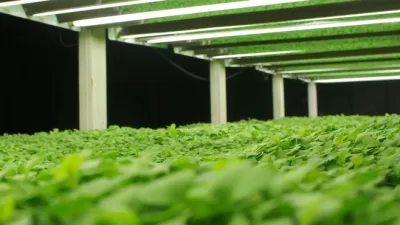Is the idea of "farming up" really taking off? Vertical farming could yield long-term environmental benefits, but still faces many obstacles.
"Want to see where your food might come from in the future?", Owen Fletcher asks, "Look up."
The potential environmental benefits of vertical farming are extensive, claim industry advocates, who believe it can help solve some of the world's most pressing environmental issues, such as contributing to slowing climate change and land reclamation. Abandoned farmlands could improve ecosystem functioning, for example. Advocates also claim that if food is grown closer to cities, trucking transport will not be as necessary, reducing carbon emissions. Indoor farming could also curtail the use of pesticides, and protect crops against traditional weather disruptions, possibly allowing for earlier harvests.
Urban farming pilot projects, and other experimental growth methods and techniques, are sprouting up as far off as Sweden and South Korea, and as close as Chicago and New York. Plantagon, for example, a Swedish company at the cutting edge of vertical farming, plans to create a 12-story, triangular farm in Linköping, Sweden, and other facilities in Shanghai or Singapore.
Still, as a business model, vertical farming has yet to prove itself, and some experts claim that the energy required to operate such facilities may cancel out some of their purported environmental benefits.
Dr. Dickson Despommier, a microbiology professor at Columbia University who developed the idea of vertical farming with students in 1999, and chief adviser to Plantagon, remains optimistic despite acknowledging evident obstacles. "You have to start small and you have to start at the research level before you jump into the commercial aspect of this thing, but that's the way all these ideas start," he says. "Everything we have in this world of ours started out crazy."
FULL STORY: The Future of Agriculture May Be Up

Alabama: Trump Terminates Settlements for Black Communities Harmed By Raw Sewage
Trump deemed the landmark civil rights agreement “illegal DEI and environmental justice policy.”

Planetizen Federal Action Tracker
A weekly monitor of how Trump’s orders and actions are impacting planners and planning in America.

The 120 Year Old Tiny Home Villages That Sheltered San Francisco’s Earthquake Refugees
More than a century ago, San Francisco mobilized to house thousands of residents displaced by the 1906 earthquake. Could their strategy offer a model for the present?

Ken Jennings Launches Transit Web Series
The Jeopardy champ wants you to ride public transit.

BLM To Rescind Public Lands Rule
The change will downgrade conservation, once again putting federal land at risk for mining and other extractive uses.

Indy Neighborhood Group Builds Temporary Multi-Use Path
Community members, aided in part by funding from the city, repurposed a vehicle lane to create a protected bike and pedestrian path for the summer season.
Urban Design for Planners 1: Software Tools
This six-course series explores essential urban design concepts using open source software and equips planners with the tools they need to participate fully in the urban design process.
Planning for Universal Design
Learn the tools for implementing Universal Design in planning regulations.
Clanton & Associates, Inc.
Jessamine County Fiscal Court
Institute for Housing and Urban Development Studies (IHS)
City of Grandview
Harvard GSD Executive Education
Toledo-Lucas County Plan Commissions
Salt Lake City
NYU Wagner Graduate School of Public Service




























